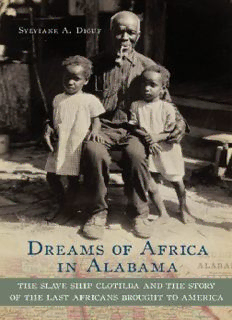
Dreams of Africa in Alabama: The Slave Ship Clotilda and the Story of the Last Africans Brought to America PDF
Preview Dreams of Africa in Alabama: The Slave Ship Clotilda and the Story of the Last Africans Brought to America
Dreams of Africa in Alabama This page intentionally left blank Dreams of Africa in Alabama The Slave Ship Clotilda and the Story of the Last Africans Brought to America S Y L V I A N E A . D I O U F 2007 Oxford University Press, Inc., publishes works that further Oxford University’s objective of excellence in research, scholarship, and education. Oxford New York Auckland Cape Town Dar es Salaam Hong Kong Karachi Kuala Lumpur Madrid Melbourne Mexico City Nairobi New Delhi Shanghai Taipei Toronto With offices in Argentina Austria Brazil Chile Czech Republic France Greece Guatemala Hungary Italy Japan Poland Portugal Singapore South Korea Switzerland Thailand Turkey Ukraine Vietnam Copyright © 2007 by Oxford University Press, Inc. Published by Oxford University Press, Inc. 198 Madison Avenue, New York, NY 10016 www.oup.com Oxford is a registered trademark of Oxford University Press All rights reserved. No part of this publication may be reproduced, stored in a retrieval system, or transmitted, in any form or by any means, electronic, mechanical, photocopying, recording, or otherwise, without the prior permission of Oxford University Press. Library of Congress Cataloging-in-Publication Data is available ISBN 978-0-19-531194-4 9 8 7 6 5 4 3 2 1 Printed in the United States of America on acid-free paper To the People of African Town, Past, Present, and Future To Sény F. and Mariam M. Kamara I goes back to Africa every night, in my dreams. —Ossa Keeby Contents Acknowledgments ix Introduction 1 Known Africans Deported to Mobile on the Clotilda 6 1 Mobile and the Slave Trades 7 2 West African Origins 30 3 Ouidah 55 4 Arrival in Mobile 72 5 Slavery 90 6 Freedom 126 viii Contents 7 African Town 151 8 Between Two Worlds 182 9 Going Back Home 207 Epilogue 233 Appendix: The Numbers of the Illegal Slave Trade 241 An Essay on Sources 245 Notes 251 Bibliography 295 Index 329 Acknowledgments I FIRST CAME ACROSS THE STORY of the young people brought to Mobile on the Clotilda in 1996. As I worked on other projects over the years, I kept it in the back of my mind. Until one day I found myself in Africatown, going over tombstones in deadly heat, and looking for records in the middle of a hurricane. As I researched and wrote this book in New York, Africatown, Mobile, Washington, and all over Bénin, I spent much time with great people and I am grateful for the assistance, encouragement, and support they gave me. I owe a huge debt of gratitude to my friend, historian Elisée Soumonni in Cotonou, for his wonderful hospitality and invaluable help, from translations to provid- ing sources, from exciting discussions to critique. I benefited immensely from Léon Degny’s research and knowledge, and from Roger N’Tia’s humor and scholarship. My gratitude goes to all the informants who answered, patiently, a tremendous amount of questions. In Mobile, I am indebted to Michael V. Thomason, former Director of the University of South Alabama Archives, where treasures are kept and shared with enthusiasm. He has been a most knowledgeable and generous host, guide, scholar, and archivist. Thanks also to archivist Carol Ellis, and to Thomas Ashby. At the Mobile County Probate Court, the wonderful Collette King went out of her way, even scouring the attic, with extraordinary warmth and passion, to help me find precious records, and I am deeply grateful to her. Henry C. Williams, Sr., shared his memories of Cudjo Lewis and his knowl- edge of Africatown. Lorna Woods and Dr. Dorothy Ford, both direct descen- dants of the Clotilda Africans, contributed their time, research, and recollections. I appreciate all the help I got from Charles J. Torrey III of The Museum of Mobile, Nancy Dupree of the Alabama Department of Archives and History, and Pamela Major of the Mobile Municipal Archives. Curator Joellen P. ElBashir, at the Manuscript Division of the Moorland- Spingarn Research Center, Howard University in Washington, D.C., has been superbly gracious and obliging. I have also been greatly helped by her colleague,
Description: